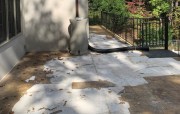Q: The American Concrete Institute has issued a new Specification for Structural Concrete. What provisions of the specification relate to the concrete as delivered by the ready-mix producer?
A: ACI 301-16, came out in early 2016. This is a “standard,” which means it went through a lengthy review and approval process and that it is written in “mandatory” language so that it can be adopted directly into a project specification. When ACI 301 is adopted, it is intended that the specification be adopted in its entirety, rather than parts since “taking them out of context may change their meaning.”
Here are a few provisions in 301-16 related to the concrete itself that every concrete contractor should know about:
- 1.6—Testing and inspection: The Specification states that “concrete materials and operations may be tested and inspected,” which means it’s not mandatory and the project specification must directly state that testing is required and who pays for it. If testing is required, though, cylinders are required (1.6.3.2(d)) for each 150 cubic yards of concrete or 5000 square feet of slabs or walls. The only exception is for jobs with less than 50 cubic yards, where the architect/engineer may waive strength tests.
- 1.6.2—Quality Control: Responsibilities of the Contractor: The specification states that “unless otherwise specified,” the contractor assumes the following duties and responsibilities: confirm that the materials meet the specification and support the owner’s testing agency by allowing access and providing electrical power and space to perform the tests.
- 1.6.6.1—Standard molded and cured strength specimens: This section defines the cylinder test results to meet the “specified compressive strength, f’c.” That is, “every average of three consecutive strength tests equals or exceeds f’c” and that “no strength test result falls below f’c by more than 500 psi, if f’c is 5000 psi or less, or by more than 0.10f’c if f’c is greater than 5000 psi.” If both of these requirements are not met then “steps shall be taken to increase the average of subsequent strength test results.”
- 4.1.2—Submittals: There is a long list of what submittals are required, including mix proportions, strength test data, mix ingredient properties, trial mix records, and “documentation that concrete meets the durability requirements of 4.2.2.7.”
- 4.2.2.5—Concrete temperature: This section specifies the minimum concrete temperature immediately after placement (55°F for small sections) and the maximum temperature of the concrete “as delivered” (95°F).
- 4.2.2.7—Durability requirements: The A/E is required to designate the exposure class and exposure category of various portions of the structure and these determine the required properties of the concrete. Exposure classes and categories are defined in ACI 318, Building Code Requirements. The categories are things like exposure to sulfate (Category S), freeze-thaw conditions (Category F), direct contact with water (Category W), or requiring corrosion protection (Category C). Within each of these categories is an exposure class that relates to the severity of the conditions. For example, in Category F, the exposure class goes from F0 to F3. For F0, the minimum specified compressive strength of the concrete is 2500 psi with a maximum water-cementitious materials ratio that is not even defined, while for exposure class F3 it is 5000 psi at a w/cm of 0.45. Air content is specified based on maximum aggregate size.
- 4.3.2—Delivery: Basically this section says that the producer must meet ASTM C94 in terms of adjusting slump with water or admixtures and also goes into the 90-minute rule—any exceptions require verification that air content, slump, and temperature meet the spec.
These are some of the highlights that most affect concrete as delivered. Contractors should become familiar with the entire Specification, especially the Mandatory and Optional Checklists at the end. These tell you what must be in the spec and what may be in the spec. ACI 301-16 is available from the American Concrete Institute, www.concrete.org.



